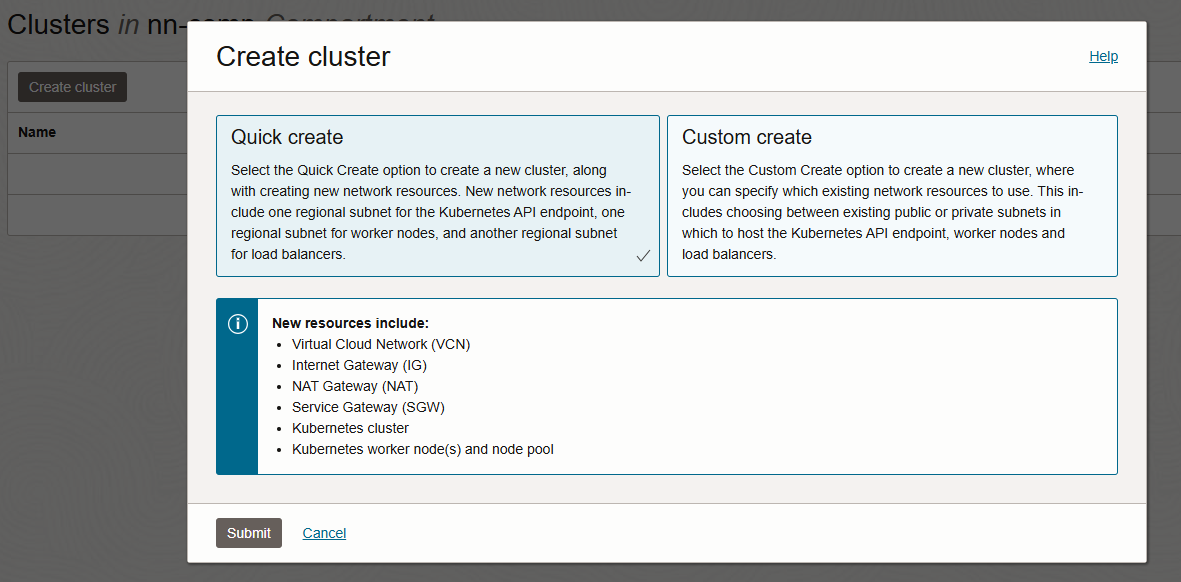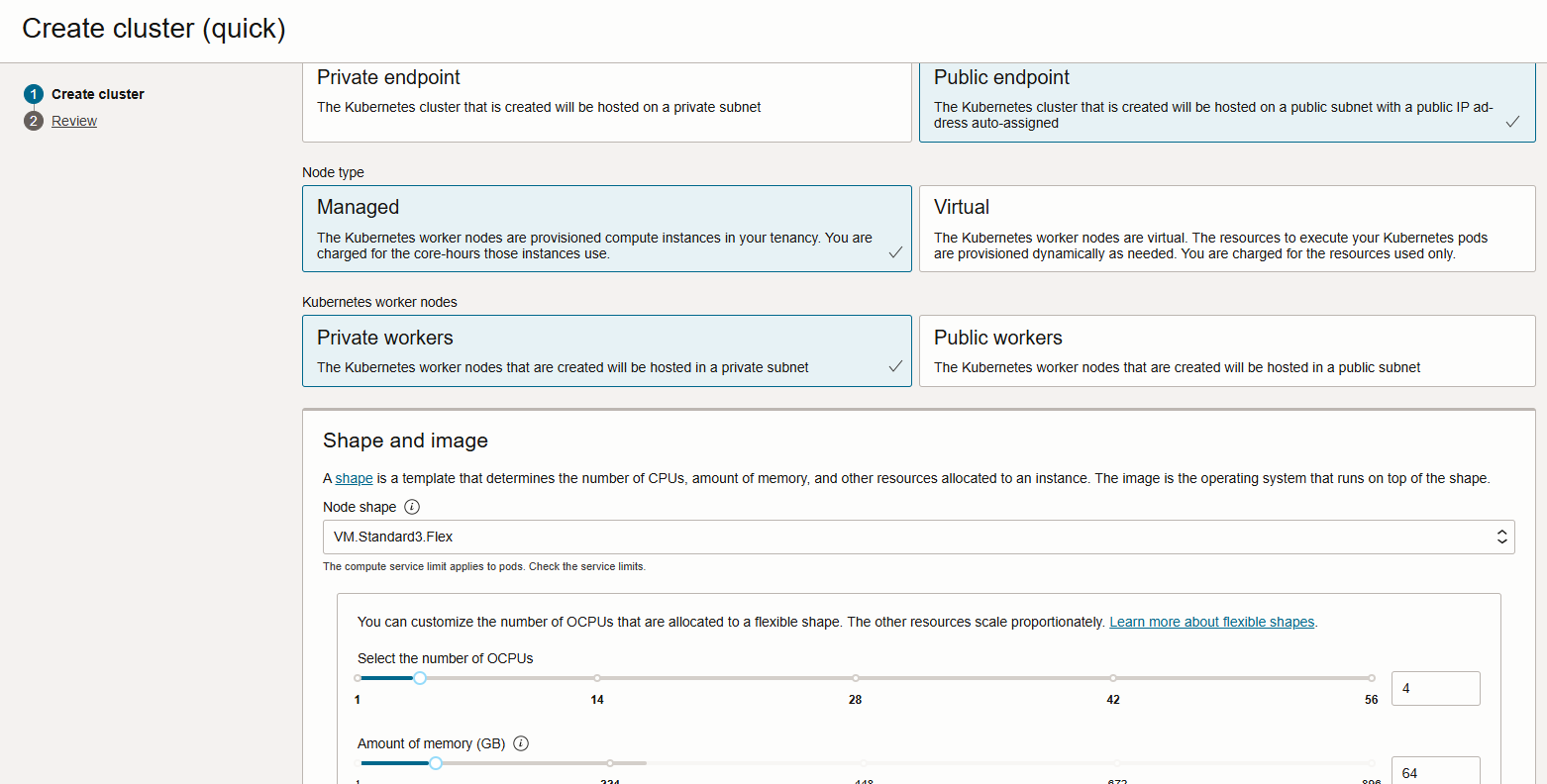In this post, we’ll deploy the HDB Price Predictor model to Oracle Cloud’s Kubernetes Engine (OKE) using KServe. The setup includes provisioning an OKE cluster, configuring Istio for networking, and serving the model using KServe.
Prerequistes
First, install the required tools:
choco install kubernetes-helm
choco install wgetStep 1: Create Oracle Kubernetes Engine (OKE)
Start by creating a new compartment.
- Navigate to Identity & Security > Compartments and click Create Compartment.
- Next, go to Developer Services > Kubernetes Clusters (OKE) and click Create Cluster.

For this demo, I created a 1-node basic cluster and waited until the node status changed to Ready and Active:

Step 2: OCI Command Line Interface (CLI)
Follow the
official OCI CLI guide
to install the CLI. I extracted the
oci-cli-3.55.0.zip
to F:\oci-cli. The API key setup is covered in the Oracle documentation, so I’ll skip it here.
Set up the environment:
F:
python -m venv oracle-cli
oracle-cli\Scripts\activate
cd \oci-cli
pip install oci_cli-3.55.0-py3-none-any.whlConfigure kubectl to access the cluster:
oci ce cluster create-kubeconfig --cluster-id ocid1.cluster.oc1.ap-singapore-2.aaaaaaaaayk5sgnphyr7rxdnwpdwfji25zcoodj52zeqlk2r3cpfpp64csya --file %USERPROFILE%/.kube/config --region ap-singapore-2 --token-version 2.0.0 --kube-endpoint PUBLIC_ENDPOINT
set KUBECONFIG=%USERPROFILE%/.kube/config
kubectl get no
# (oracle-cli) F:\oci-cli>kubectl get no
# NAME STATUS ROLES AGE VERSION
# 10.0.10.184 Ready node 40s v1.33.0Step 3: Install KServe and Dependencies
3.1 Install Cert Manager
Follow the KServe 0.15 setup guide :
kubectl apply -f https://github.com/cert-manager/cert-manager/releases/download/v1.17.2/cert-manager.yaml
kubectl get deployments -n cert-manager3.2 Install Istio via Helm
Referencing Istio’s Helm installation guide :
helm repo add istio https://istio-release.storage.googleapis.com/charts
helm repo update
helm install istio-base istio/base -n istio-system --set defaultRevision=default --create-namespace
helm install istiod istio/istiod -n istio-system --wait
helm ls -n istio-system
helm install istio-ingressgateway istio/gateway -n istio-system --wait
helm status istio-ingressgateway -n istio-systemApply the IngressClass:
# istio-ingressclass.yaml
apiVersion: networking.k8s.io/v1
kind: IngressClass
metadata:
name: istio
spec:
controller: istio.io/ingress-controllerkubectl apply -f istio-ingressclass.yaml3.3 Install KServe
helm install kserve-crd oci://ghcr.io/kserve/charts/kserve-crd --version v0.15.0 -n kserve --create-namespace
helm install kserve oci://ghcr.io/kserve/charts/kserve --version v0.15.0 --set kserve.controller.deploymentMode=RawDeployment --set kserve.controller.gateway.ingressGateway.className=istio -n kserve --create-namespaceStep 4: Deploy Your First InferenceService
We’ll use the KServe getting started example :
# sklearn-iris.yaml
apiVersion: "serving.kserve.io/v1beta1"
kind: "InferenceService"
metadata:
name: "sklearn-iris"
namespace: kserve-test
spec:
predictor:
model:
modelFormat:
name: sklearn
storageUri: "gs://kfserving-examples/models/sklearn/1.0/model" kubectl create namespace kserve-test
kubectl apply -n kserve-test -f sklearn-iris.yaml
kubectl get inferenceservices sklearn-iris -n kserve-testCheck the external IP of the Istio ingress gateway:
kubectl get svc istio-ingressgateway -n istio-systemThen run a prediction request:
curl -v -H "Host: sklearn-iris-kserve-test.example.com" -H "Content-Type: application/json" "http://217.142.185.27:80/v1/models/sklearn-iris:predict" -d @iris-input.jsonTo automate, extract necessary variables:
# INGRESS_HOST
kubectl -n istio-system get service istio-ingressgateway -o jsonpath='{.status.loadBalancer.ingress[0].ip}'
# INGRESS_PORT
kubectl -n istio-system get service istio-ingressgateway -o jsonpath='{.spec.ports[?(@.name=="http2")].port}'
# SERVICE_HOSTNAME
kubectl get inferenceservice sklearn-iris -n kserve-test -o jsonpath='{.status.url}' | cut -d "/" -f 3Step 5: Deploy HDB Price Predictor
With the model files downloaded from my homelab MinIO, as shared in my
previous post
, we now upload the price-predictor-model.bst to an Oracle Cloud Object Storage bucket. Once uploaded, define an InferenceService to deploy the XGBoost model:
# price-predictor-xgboost.yaml
apiVersion: "serving.kserve.io/v1beta1"
kind: "InferenceService"
metadata:
name: "hdb-resale-xgb"
namespace: kserve-test
spec:
predictor:
model:
modelFormat:
name: xgboost
runtime: "kserve-xgbserver"
protocolVersion: v2
storageUri: "https://objectstorage...oraclecloud.com/.../price-predictor-model.bst" Apply the manifest and check the deployment status:
kubectl apply -f price-predictor-xgboost.yaml
kubectl get inferenceservices hdb-resale-xgb -n kserve-testUse the following input JSON for prediction:
{"inputs":[
{"name":"input-0",
"shape":[2,59],
"datatype":"FP32",
"data":[
0.43119266629219055,0.6242774724960327,0.1875,0.125,0.6363636255264282,0.0,0.0,0.0,0.0,1.0,0.0,0.0,0.0,0.0,0.0,0.0,0.0,1.0,0.0,0.0,0.0,0.0,0.0,0.0,0.0,0.0,0.0,0.0,0.0,0.0,0.0,0.0,0.0,0.0,0.0,0.0,0.0,0.0,0.0,0.0,0.0,1.0,0.0,0.0,0.0,0.0,0.0,0.0,0.0,0.0,0.0,0.0,0.0,0.0,0.0,0.0,0.0,0.0,0.0,
0.2844036817550659,0.8858381509780884,0.125,0.5,0.8181818127632141,0.0,0.0,0.0,1.0,0.0,0.0,0.0,0.0,0.0,0.0,0.0,0.0,0.0,0.0,0.0,1.0,0.0,0.0,0.0,0.0,0.0,0.0,0.0,0.0,0.0,0.0,0.0,0.0,0.0,0.0,0.0,0.0,0.0,0.0,0.0,0.0,0.0,0.0,0.0,0.0,0.0,0.0,0.0,0.0,0.0,0.0,0.0,0.0,1.0,0.0,0.0,0.0,0.0,0.0
]}
]}To send the inference request, first retrieve the service hostname:
kubectl get inferenceservice hdb-resale-xgb -n kserve-test -o jsonpath='{.status.url}' | cut -d "/" -f 3Then send the prediction using curl:
curl -v -H "Host: hdb-resale-xgb-kserve-test.example.com" -H "Content-Type: application/json" "http://217.142.185.27:80/v2/models/hdb-resale-xgb/infer" -d @inference-input.json
Step 6: Connect Streamlit App to KServe Inference Endpoint
Instead of deploying the frontend app in-cluster, the HDB Resale Price Predictor is hosted on Streamlit Community Cloud . It interacts with the XGBoost model served on Oracle Kubernetes Engine (OKE) via KServe and Istio.
The app sends prediction requests to the public inference endpoint exposed through Istio Gateway. The request includes appropriate headers to route traffic correctly using the Host field, as shown below:
KSERVE_URL = os.environ.get("KSERVE_URL", "http://<public-ip>:80/v2/models/hdb-resale-xgb/infer")
KSERVE_HOST = os.environ.get("KSERVE_HOST", "hdb-resale-xgb-kserve-test.example.com")
headers = {"Content-Type": "application/json"}
if KSERVE_HOST:
headers["Host"] = KSERVE_HOST
response = requests.post(KSERVE_URL, headers=headers, json=payload, timeout=30)You can explore the complete Streamlit source code on GitHub: https://github.com/seehiong/hdb-price-predictor
